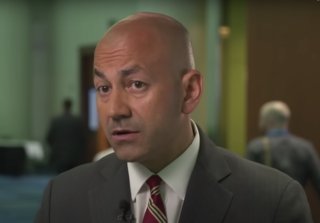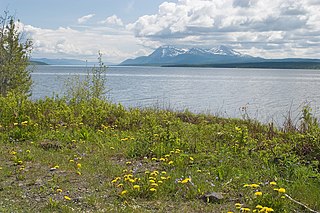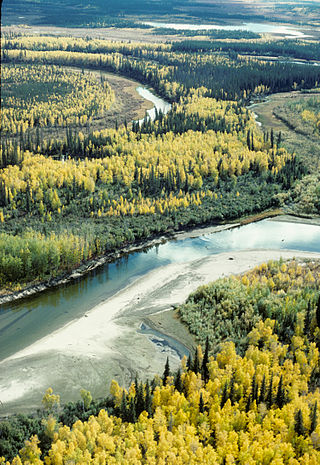
Yukon is one of Canada's territories, and has established several territorial symbols. [1]

Yukon is one of Canada's territories, and has established several territorial symbols. [1]
| Symbol | Image | Adopted | Remarks | |
|---|---|---|---|---|
| Coat of arms | Coat of arms of Yukon |  | 1956 | It was approved officially by Queen Elizabeth II |
| Flag | Flag of Yukon | March 1, 1968 | ||
| Shield of arms | Shield of arms of Yukon |  | 1956 | Granted with other elements of the coat of arms |
| Floral | Fireweed (Epilobium angustifolium) |  | 1957 | |
| Tree | Subalpine fir (Abies lasiocarpa) |  | 2001 | The sap drawn from the blisters on its bark has been used by First Nation people as a traditional medicine for lung ailments. |
| Bird | Raven (Corvus corax) |  | 1985 | The raven is seen everywhere in Yukon. Raven is called "crow" by Yukon First Nations people. |
| Gemstone | Lazulite | February 1976 | Lazulite is found in the layered sedimentary rock of the Blow River area in Ivvavik National Park. The colour and crystalline qualities of Yukon's lazulite are among the finest in the world. | |
| Tartan | Woven cloth that is composed of green, dark blue, magenta, yellow and white stripes in varying widths on a light blue background. | 1984 | ||
Like Nunavut, Yukon does not have an official Great Seal.

Yukon is the smallest and westernmost of Canada's three territories. It also is the second-least populated province or territory in Canada, with a population of 44,238 as of March 2023. Whitehorse, the territorial capital, is the largest settlement in any of the three territories.

The premier of Yukon is the first minister and head of government for the Canadian territory of Yukon. The post is the territory's head of government, although its powers are considerably more limited than that of a provincial premier. The office was established in 1978 when most authority was devolved from the appointed commissioner to the leader of the party that had the confidence of the Yukon Legislative Assembly; for the year immediately prior to this, that leader was one of the members serving with the commissioner's Executive Committee.

The flag of Yukon, is a green, white, and blue tricolour with the coat of arms of Yukon at the centre above a wreath of fireweed, the territorial flower. An official flag for Yukon was created during the 1960s, a decade in which the national flag of Canada was chosen as well as several other provincial flags were created. The flag of Yukon was officially selected from a territory-wide design competition in 1967, with the winning design adopted on March 1, 1968.

The Eye of Providence is a figure that depicts an eye, often enclosed in a triangle and surrounded by rays of light or glory, meant to represent divine providence whereby the eye of God watches over humanity. The Eye of Providence is a widely recognized symbol, giving it instrumentality in the fields of iconography and semiotics. A well known example of the Eye of Providence appears on the reverse of the Great Seal of the United States, which is depicted on the United States one-dollar bill.

The Gwichʼin language belongs to the Athabaskan language family and is spoken by the Gwich'in First Nation (Canada) / Alaska Native People. It is also known in older or dialect-specific publications as Kutchin, Takudh, Tukudh, or Loucheux. Gwich'in is spoken primarily in the towns of Inuvik, Aklavik, Fort McPherson, and Tsiigehtchic, all in the Northwest Territories and Old Crow in Yukon of Canada. In Alaska of the United States, Gwichʼin is spoken in Beaver, Circle, Fort Yukon, Chalkyitsik, Birch Creek, Arctic Village, Eagle, and Venetie.

The coat of arms of Yukon is the heraldic symbol representing the Canadian territory of Yukon. The arms was commissioned by the federal Department of Indian Affairs and Northern Development and designed by well-known heraldry expert Alan Beddoe in the early 1950s. It was officially approved by Queen Elizabeth II in 1956.

The original coat of arms of the Northwest Territories was granted by a Royal Warrant of Queen Elizabeth II on 24 February 1956. The shield is also featured on the territorial flag. The coat of arms was designed by well known Canadian heraldry expert Alan Beddoe in the early 1950s.

The Chevrolet Suburban is a series of automobiles built by the Chevrolet division of General Motors. In production since the 1935 model year, the model line is currently in its twelfth generation; it is the longest-used automobile nameplate in the world. Beginning life as one of the first metal-bodied station wagons, the Suburban is the progenitor of modern full-size SUVs, combining a station wagon body with the chassis and powertrain of a pickup truck. Alongside its Advance Design, Task Force and C/K predecessors, the Silverado pickup trucks share chassis and mechanical commonality with the Suburban.

The Chevrolet Tahoe, and its badge engineered GMC Yukon counterpart, are full-size SUVs from General Motors, offered since 1994 and 1991, respectively. Since 1982, Chevrolet and GMC sold two different-sized SUVs under their 'Blazer' and 'Jimmy' nameplates, by introducing the smaller S-10 Blazer and GMC S-15 Jimmy for the 1983 model year, below the full-size Blazer and Jimmy models. This situation lasted into the early 1990s. GMC first rebadged the full-size Jimmy as the 'Yukon' in 1991. Chevrolet however waited until 1994, when they rebadged the redesigned mid-size S-10 Blazer as their 'new Blazer', while renaming the full-size Blazer as the 'Tahoe'. The name Tahoe refers to the rugged and scenic area surrounding Lake Tahoe in the western United States. The name Yukon refers to the Yukon territory of northern Canada.

Mount Kennedy is a peak in the Saint Elias Mountains within Kluane National Park, in Yukon, Canada. Its 4250-m to 4300-m (14000-foot) summit lies within 10 km of the Alaska Panhandle. Dusty Glacier lies against it to the north.

The Porcupine caribou(Rangifer tarandus groenlandicus) is a herd or ecotype of barren-ground caribou, the subspecies of the reindeer or caribou found in Alaska, United States, and Yukon and the Northwest Territories, Canada. A recent revision changes the Latin name; see Taxonomy.
The Denali nameplate is used by GMC for its highest trim level on its vehicles. Vehicles with the Denali trim option carry list prices up to 47% higher than base models. Prices range from $40,240 for GMC Terrain to $81,270 for a top-of-the-line Yukon XL Denali. The Denali nameplate is often used as an insignia or status symbol, and in particular is popular as a less costly alternative to the Cadillac Escalade. The Yukon Denali line typically represents 40% of Yukon sales in both units and dollars. In 2013 it sold more than 75,558 units of the Denali brand, which accounted for 20% of GMC's sales, making it one of GM's most successful sub-brands.
The Ecclesiastical Province of British Columbia and Yukon is one of four ecclesiastical provinces in the Anglican Church of Canada. It was founded in 1914 as the Ecclesiastical Province of British Columbia, but changed its name in 1943 when the Diocese of Yukon was incorporated from the Ecclesiastical Province of Rupert's Land. The territory covered by the province encompasses the civil province of British Columbia and Yukon. There are five dioceses and one "recognized territory [with] the status of a diocese" in the province:

The following outline is provided as an overview of and topical guide to Canada:

Teslin Lake is a large lake spanning the border between British Columbia and Yukon, Canada. It is one of a group of large lakes in the region of far northwestern BC, east of the upper Alaska Panhandle, which are the southern extremity of the basin of the Yukon River, and which are known in Yukon as "the Southern Lakes". The lake is fed and drained primarily by the Teslin River, south and north, but is also fed from the east by the Jennings River and the Swift River, and from the west by the Hayes River.

The Yukon Flats National Wildlife Refuge is a protected wetland area in the U.S. state of Alaska. It encompasses most of the Yukon Flats, a vast wetland area centered on the confluence of the Yukon River, Porcupine River, and Chandalar River.
The culture of North America refers to the arts and other manifestations of human activities and achievements from the continent of North America. Cultures of North America reflect not only that of the continent's indigenous peoples but those cultures that followed European colonisation as well.
The following outline is provided as an overview of and topical guide to Yukon.
Ronald A. Rivett was a Canadian politician who served on the Yukon Territorial Council from 1970 to 1974. He was elected in the 1970 Yukon general election for the district of Mayo, and served as speaker of the council during his term. He was a bookkeeper. On March 6, 1972, Rivett accepted the Yukon Territorial Mace as a gift from Governor General Roland Michener. Rivett died at a hospital in Whitehorse in 1977 at the age of 59.